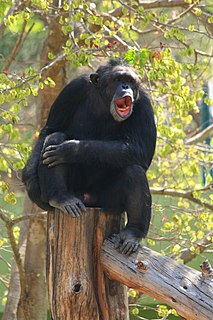 W
WBrachiation, or arm swinging, is a form of arboreal locomotion in which primates swing from tree limb to tree limb using only their arms. During brachiation, the body is alternately supported under each forelimb. This form of locomotion is the primary means of locomotion for the small gibbons and siamangs of southeast Asia. Gibbons in particular use brachiation for as much as 80% of their locomotor activities. Some New World monkeys, such as spider monkeys and muriquis, were initially classified as semibrachiators and move through the trees with a combination of leaping and brachiation. Some New World species also practice suspensory behaviors by using their prehensile tail, which acts as a fifth grasping hand. Evidence has shown that the extinct ape Proconsul from the Milocene of East Africa developed an early form of suspensory behaviour, and was therefore referred to as a probrachiator.
 W
WA gecker is a vocalization most often associated with infant primates. It is defined as a loud and distinct vocalization, which consists of a broken staccato noise. In 1965, Irven DeVore of the Center for Advanced Study in the Behavioral Sciences described geckering as a "single sharp yak sound", which may be repeated. It has also been characterized as "cackling." It is common in to all types of macaques, geckering is also associated with fearful jackals and mongooses. Patas monkeys have also been observed to gecker. In macaques, bickering is associated with spastic jerking of the body. Geckers are also commonly displayed in combination with grimaces.
 W
WThe Gombe Chimpanzee War was a violent conflict between two communities of chimpanzees in Gombe Stream National Park in Tanzania lasting from 1974 to 1978. The two groups were once unified in the Kasakela community. By 1974, researcher Jane Goodall noticed the community splintering. Over a span of eight months, a large party of chimpanzees separated themselves into the southern area of Kasakela and were renamed the Kahama community. The separatists consisted of six adult males, three adult females and their young. The Kasakela was left with eight adult males, twelve adult females and their young.
 W
WJoint attention or shared attention is the shared focus of two individuals on an object. It is achieved when one individual alerts another to an object by means of eye-gazing, pointing or other verbal or non-verbal indications. An individual gazes at another individual, points to an object and then returns their gaze to the individual. Scaife and Bruner were the first researchers to present a cross-sectional description of children's ability to follow eye gaze in 1975. They found that most eight- to ten-month-old children followed a line of regard, and that all 11- to 14-month-old children did so. This early research showed it was possible for an adult to bring certain objects in the environment to an infant's attention using eye gaze.
 W
WNest-building in primates refers to the behaviour of building nests by extant strepsirrhines and hominid apes. Strepsirrhines build nests for both sleeping and also for raising families. Hominid apes build nests for sleeping at night, and in some species, for sleeping during the day. Nest-building by hominid apes is learned by infants watching the mother and others in the group, and is considered tool use rather than animal architecture. Old World monkeys and New World monkeys do not nest. It has been speculated that a major evolutionary advance in the cognitive abilities of hominoids may first have occurred due to the development of nest-building behaviour and that the transition from nest-building to ground-sleeping led to "modifications in the quality and quantity of hominid sleep, which in turn may have enhanced waking survival skills through priming, promoted creativity and innovation, and aided the consolidation of procedural memories".
 W
WThe pant-hoot (call) is a well-studied, structurally complex and long-distance vocalization of chimpanzees. The call is generally divided into four distinct, successive phases: introduction, build-up, climax and let-down. This introductory phase begins with soft, breathy, low-frequency 'hoo's' that transition into the build-up phase; a series of increasingly rapid, low-frequency in-and-out pants. Following the build-up phase, the call quickly builds into the climax, consisting of loud, high-frequency screams that eventually slow into the let-down phase, similar in structure to the build-up, but with decreasing amplitude and pace until the call is complete.
 W
WPrimate sociality is an area of primatology that aims to study the interactions between three main elements of a primate social network: the social organisation, the social structure and the mating system. The intersection of these three structures describe the socially complex behaviours and relationships occurring among adult males and females of a particular species. Cohesion and stability of groups are maintained through a confluence of factors, including: kinship, willingness to cooperate, frequency of agonistic behaviours, or varying intensities of dominance structures.